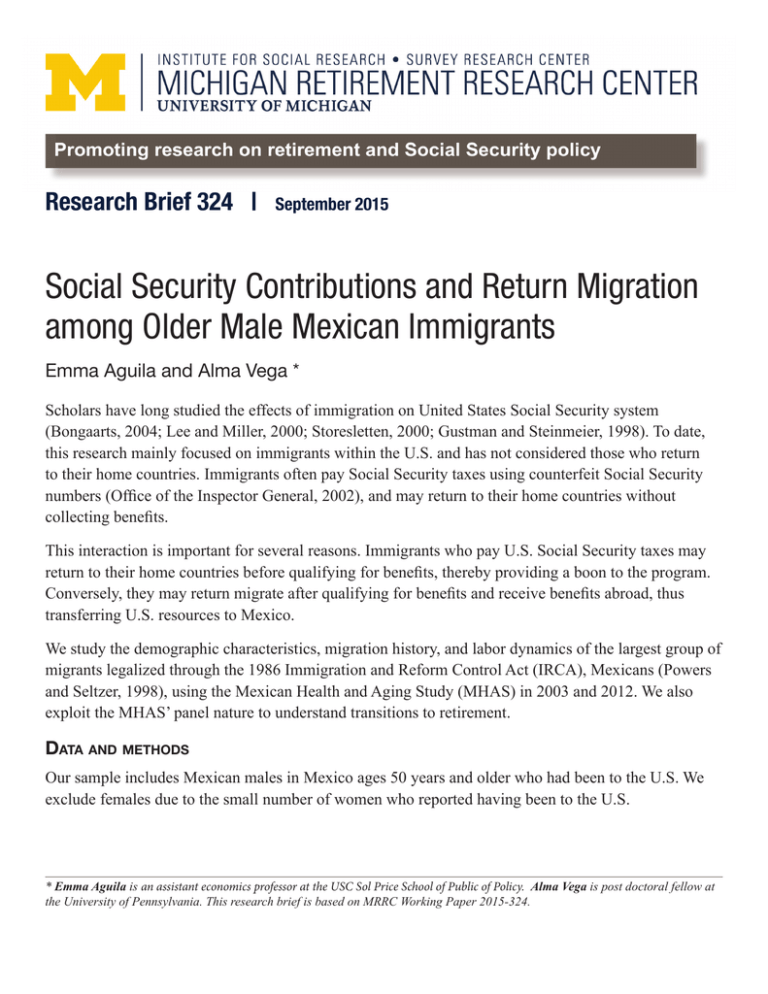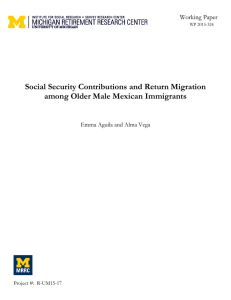Social Security Contributions and Return Migration among Older Male Mexican Immigrants
advertisement

Research Brief 324 | September 2015 Social Security Contributions and Return Migration among Older Male Mexican Immigrants Emma Aguila and Alma Vega * Scholars have long studied the effects of immigration on United States Social Security system (Bongaarts, 2004; Lee and Miller, 2000; Storesletten, 2000; Gustman and Steinmeier, 1998). To date, this research mainly focused on immigrants within the U.S. and has not considered those who return to their home countries. Immigrants often pay Social Security taxes using counterfeit Social Security numbers (Office of the Inspector General, 2002), and may return to their home countries without collecting benefits. This interaction is important for several reasons. Immigrants who pay U.S. Social Security taxes may return to their home countries before qualifying for benefits, thereby providing a boon to the program. Conversely, they may return migrate after qualifying for benefits and receive benefits abroad, thus transferring U.S. resources to Mexico. We study the demographic characteristics, migration history, and labor dynamics of the largest group of migrants legalized through the 1986 Immigration and Reform Control Act (IRCA), Mexicans (Powers and Seltzer, 1998), using the Mexican Health and Aging Study (MHAS) in 2003 and 2012. We also exploit the MHAS’ panel nature to understand transitions to retirement. Data anD methoDs Our sample includes Mexican males in Mexico ages 50 years and older who had been to the U.S. We exclude females due to the small number of women who reported having been to the U.S. * Emma Aguila is an assistant economics professor at the USC Sol Price School of Public of Policy. Alma Vega is post doctoral fellow at the University of Pennsylvania. This research brief is based on MRRC Working Paper 2015-324. M Table 1 shows that approximately 16 percent of Mexican males in Mexico in both 2003 and 2012 reported having returned from the U.S. at some point (Panel A). Of this 16 percent, 40 percent and 32 percent reported having contributed to the U.S. Social Security system while in the U.S. in 2003 and 2012, respectively. These are likely conservative estimates that do not capture migrants who paid U.S. Social Security taxes without knowing. While illuminating, the effects of these contributions to the U.S. economy depend on the characteristics of those who paid these taxes. Those who contributed to the U.S. Social Security system are only eligible to receive benefits in the U.S. if they obtained U.S. legal status before retirement and contributed to the U.S. Social Security system for at least 10 years. It was not possible to know from these data the exact number of years migrants worked in the U.S., only the total number of years they lived in the U.S. As many Mexican males travel to the U.S. primarily to work (Cerrutti and Massey, 2001), it is not farfetched to assume they worked most, if not all, of the years they were in the U.S. We find that in 2003, 15 percent of return migrants who had contributed were U.S. citizens or legal permanent residents, and 22 percent spent at least 10 years in the U.S. These numbers were 21 percent and 22 percent in 2012, respectively. The relatively low proportion of return migrants who fall into these categories helps explain why so few of those who paid U.S. Social Security taxes expected to collect benefits in the future. In 2012, of those who contributed to the U.S. Social Security system, only five percent received or expected to receive benefits. This result supports the Office of the Chief Actuary’s belief that relatively few migrants who could potentially draw benefits do so (Goss et al., 2013). We also find that, compared to those who did not pay U.S. Social Security taxes, those who did pay U.S. Social Security taxes were more likely to be U.S. citizens or legal permanent residents and to have completed college and spent more years in the U.S. Finally, we examined the transitions to retirement among males who were employed in 2012. We find that of all ex-U.S. migrants employed in 2003, 32 percent were still working in 2012. Using a probit regression model we find that the probability of retiring between 2003 and 2012 was: • Higher for older respondents; • Higher for those who were widowed in 2003 compared to those who were single; • Lower for those who spent one to nine years in the U.S. compared to those who had never been to the U.S.; • Higher for those who spent 20 or more years in the U.S. compared to those who had never been to the U.S.; • Higher for respondents who were fixed salary employees as of 2003; • Lower for those of intermediary income levels in 2003. summary Our results suggest that a sizeable percentage of older ex-U.S. migrant males in Mexico contributed to the U.S. Social Security system while in the U.S., but few received or expect to receive benefits in the future. Several factors help explain this result. For example, we find that, by the time of the survey, few of those who contributed and returned to Mexico had become U.S. legal permanent residents or U.S. citizens, which is necessary before collecting benefits (Goss et al., 2013). Technically, a legal immigrant is eligible to collect benefits from wages made as an undocumented immigrant, but few are thought to actually do so (Goss et al., 2013). Table 1. ProPorTion of Mexican Males living in Mexico ages 50 years and older who aT soMe PoinT reTurned froM The uniTed sTaTes, 2003 and 2012 cross-secTions 2003 N Total Sample Never lived in U.S. Lived in U.S. Panel B: Contributed Total who Lived in U.S. to the U.S. Social Se- Didn’t contribute curity system Contributed Total who Panel C: Receive or contributed expect to receive U.S. Social Security Do not receive/expect to benefits receive Receive/ expect to receive Panel A: Lived in the United States at some point 5,112 4,289 818 818 462 328 328 2012 % 83.90 16.00 56.50 40.10 N 5,844 4,918 913 913 562 292 292 % 84.20 15.60 61.60 32.00 N/A N/A 275 94.18 N/A N/A 12 5.14 Source: Authors’ calculations using the Mexican Health and Aging Study (MHAS), 2003 and 2012. Notes: Estimates are unweighted. Percentages do not add to 100% due to missing values. N/A is not available for data in 2003 due to questionnaire skip patterns. references Bongaarts, John. 2004. “Population Aging and the Rising Costs of Public Pensions.” Population and Development Review 30 (1):1-23. Cerrutti, Marcela, and Douglas S. Massey. 2001. “On the Auspices of Female Migration from Mexico to the United States.” Demography 38 (2):187-200. doi: 10.1353/dem.2001.0013 Goss, Stephen, Alice Wade, J Patrick Skirvin, Michael Morris, K Mark Bye, and Danielle Huston. 2013. “Effects of Unauthorized Immigration on the Actuarial Status of the Social Security Trust Funds.” Actuarial Note 151. Baltimore, MD: U.S. Social Security Administration. Gustman, Alan L., and Thomas L. Steinmeier. 1998. “Social Security Benefits of Immigrants and U.S. Born.” Working Paper 1998. Washington, D.C.: Lee, Ronald, and Timothy Miller. 2000. “Immigration, Social Security, and Broader Fiscal Impacts.” The American Economic Review: Papers and Proceedings of the One Hundred and Twelfth Annual Meeting of the American Economic Association 90 (2):350-354. Office of the Inspector General. 2002. “Status of the Social Security Administration’s Earnings Suspense File.” Congressional Response Report A-03-03-23028. Washington, D.C.: Author. Storesletten, Kjetil. 2000. “Sustaining Fiscal Policy through Immigration.” Journal of Political Economy 108 (2):300-323. University of Michigan Retirement Research Center Institute for Social Research 426 Thompson Street Room 3026 Ann Arbor, MI 48104-2321 Phone: (734) 615-0422 Fax: (734) 615-2180 mrrcumich@umich.edu www.mrrc.isr.umich.edu Sponsor Information: The research reported herein was performed pursuant to a grant from the U.S. Social Security Administration (SSA) through the Michigan Retirement Research Center (MRRC). The findings and conclusions expressed are solely those of the author(s) and do not represent the views of SSA, any agency of the federal government, or the MRRC. Regents of the University of Michigan: Michael J. Behm, Grand Blanc; Mark J. Bernstein, Ann Arbor; Laurence B. Deitch, Bloomfield Hills; Shauna Ryder Diggs, Grosse Pointe; Denise Ilitch, Bingham Farms; Andrea Fischer Newman, Ann Arbor; Andrew C. Richner, Grosse Pointe Park; Katherine E. White, Ann Arbor; Mark S. Schlissel, ex officio







